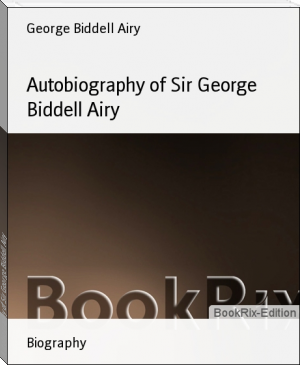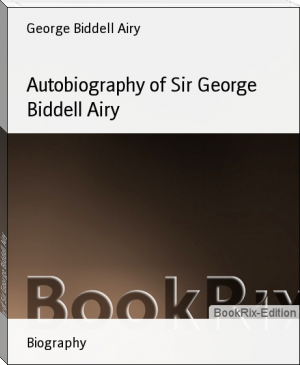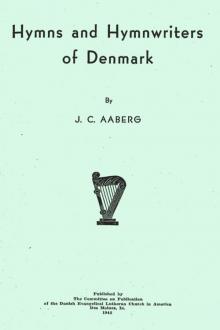Autobiography of Sir George Biddell Airy, George Biddell Airy [dark books to read TXT] 📗

- Author: George Biddell Airy
Book online «Autobiography of Sir George Biddell Airy, George Biddell Airy [dark books to read TXT] 📗». Author George Biddell Airy
latest Norman. I never saw one so well marked before--Norman ornaments on pointed arches, pilasters detached with cushion capitals, and various signs: and it is clearly an instance of that state of the style when people had been forced by the difficulties and inelegancies of the round arch in groining to adopt pointed arches for groining but had not learnt to use them for windows.......This morning after breakfast went to the Cathedral (looking by the way at a curious old cross in the street). I thought that its inside was wholly Norman, and was most agreeably surprised by finding the whole inside groined in every part with excellent late decorated or perpendicular work. Yet there are several signs about it which lead me to think that the whole inside has been Norman, and even that the pilasters now worked up into the perpendicular are Norman. The transepts are most massive old Norman, with side-aisles running round their ends (which I never saw before). The groining of the side aisles of the nave very effective from the strength of the cross ribs. The clerestory windows of the quire very large. The organ is on one side. But the best thing about the quire is the wooden stall-work, of early decorated, very beautiful. A superb Lady Chapel, of early English.
* * * * *
PORTSMOUTH,
_1840, June 23_.
We left Winchester by evening train to the Dolphin, Southampton, and slept there. At nine in the morning we went by steamboat down the river to Ryde in the Isle of Wight: our steamer was going on to Portsmouth, but we thought it better to land at Ryde and take a boat for ourselves. We then sailed out (rather a blowing day) to the vessel attending Col. Pasley's operations, and after a good deal of going from one boat to another (the sea being so rough that our boat could not be got up to the ships) and a good deal of waiting, we got on board the barge or lump in which Col. Pasley was. Here we had the satisfaction of seeing the barrel of gunpowder lowered (there was more than a ton of gunpowder), and seeing the divers go down to fix it, dressed in their diving helmets and supplied with air from the great air-pump above. When all was ready and the divers had ascended again, the barge in which we were was warped away, and by a galvanic battery in another barge (which we had seen carried there, and whose connection with the barrel we had seen), upon signal given by sound of trumpet, the gunpowder was fired. The effect was most wonderful. The firing followed the signal instantaneously. We were at between 100 and 200 yards from the place (as I judge), and the effects were as follows. As soon as the signal was given, there was a report, louder than a musket but not so loud as a small cannon, and a severe shock was felt at our feet, just as if our barge had struck on a rock. Almost immediately, a very slight swell was perceived over the place of the explosion, and the water looked rather foamy: then in about a second it began to rise, and there was the most enormous outbreak of spray that you can conceive. It rose in one column of 60 or 70 feet high, and broad at the base, resembling a stumpy sheaf with jagged masses of spray spreading out at the sides, and seemed to grow outwards till I almost feared that it was coming to us. It sunk, I suppose, in separate parts, for it did not make any grand squash down, and then there were seen logs of wood rising, and a dense mass of black mud, which spread gradually round till it occupied a very large space. Fish were stunned by it: our boatmen picked up some. It was said by all present that this was the best explosion which had been seen: it was truly wonderful. Then we sailed to Portsmouth.......The explosion was a thing worth going many miles to see. There were many yachts and sailing boats out to see it (I counted 26 before they were at the fullest), so that the scene was very gay.
* * * * *
Here are some notes on York Cathedral after the fire:
RED LION HOTEL, REDCAR,
_1840, Sept. 7_.
My first letter was closed after service at York Cathedral. As soon as I had posted it, I walked sedately twice round the cathedral, and then I found the sexton at the door, who commiserating me of my former vain applications, and having the hope of lucre before his eyes, let me in. I saw the burnt part, which looks not melancholy but unfinished. Every bit of wood is carried away clean, with scarcely a smoke-daub to mark where it has been: the building looks as if the walls were just prepared for a roof, but there are some deep dints in the pavement, shewing where large masses have fallen. The lower parts of some of the columns (to the height of 8 or 10 feet) are much scaled and cracked. The windows are scarcely touched. I also refreshed my memory of the chapter-house, which is most beautiful, and which has much of its old gilding reasonably bright, and some of its old paint quite conspicuous. And I looked again at the old crypt with its late Norman work, and at the still older crypt of the pre-existing church.
* * * * *
1841
"The routine work of the Observatory in its several departments was carried on steadily during this year.--The Camera Obscura was removed from the N.W. Turret of the Great Room, to make way for the Anemometer.--In Magnetism and Meteorology the most important thing was the great magnetic storm of Sept. 29th, which revealed a new class of magnetic phenomena. It was very well observed by Mr Glaisher, and I immediately printed and circulated an account of it.--In April I reported that the Planetary Reductions were completed, and furnished estimates for the printing.--In August I applied for 18,000 copies of the great skeleton form for computing Lunar Tabular Places, which were granted.--I reported, as usual, on various Papers for the Royal Society, and was still engaged on the Cavendish Experiment.--In the University of London I attended the meeting of Dec. 8th, on the reduction of Examiners' salaries, which were extravagant.--I furnished Col. Colby with a plan of a new Sector, still used in the British Survey.--I appealed to Colby about the injury to the cistern on the Great Gable in Cumberland, by the pile raised for the Survey Signal.--On Jan. 3rd occurred a most remarkable tidal disturbance: the tide in the Thames was 5 feet too low. I endeavoured to trace it on the coasts, and had a vast amount of correspondence: but it elicited little.
"Of private history: I was a short time in Suffolk in March.--On Mar. 31st I started with my wife (whose health had suffered much) for a trip to Bath, Bristol, Cardiff, Swansea, &c. While at Swansea we received news on Apr. 24th of the deadly illness of my dear mother. We travelled by Neath and Cardiff to Bath, where I solicited a rest for my wife from my kind friend Miss Sutcliffe, and returned alone to Greenwich. My dear mother had died on the morning of the 24th. The funeral took place at Little Whelnetham (near Bury) on May 1st, where my mother was buried by the side of my father. We went to Cambridge, where my wife consulted Dr Haviland to her great advantage, and returned to Greenwich on May 7th.--On May 14th to 16th I was at Sanderstead (Rev. J. Courtney) with Whewell as one sponsor, at the christening of my daughter Hilda.--In September I went for a trip with my sister to Yorkshire and Cumberland, in the course of which we visited Dent (Sedgwick's birthplace), and paid visits to Mr Wordsworth, Miss Southey, and Miss Bristow, returning to Greenwich on the 30th Sept.--From June 15th to 19th I visited my brother at Keysoe."
The following extracts are from letters written to his wife while on the above trip in Yorkshire and Cumberland:
RED LION INN, REDCAR,
_1841, Sept. 11_.
We stopped at York: went to the Tavern Hotel. In the morning (Friday) went into the Cathedral. I think that it improves on acquaintance. The nave is now almost filled with scaffolding for the repair of the roof, so that it has not the bare unfinished appearance that it had when I was there last year. The tower in which the fire began seems to be a good deal repaired: there are new mullions in its windows, &c. We stopped to hear part of the service, which was not very effective.
* * * * *
Here are notes of his visit to Dentdale in Yorkshire, the birthplace of his friend Sedgwick:
* * * * *
PORTSMOUTH,
_1840, June 23_.
We left Winchester by evening train to the Dolphin, Southampton, and slept there. At nine in the morning we went by steamboat down the river to Ryde in the Isle of Wight: our steamer was going on to Portsmouth, but we thought it better to land at Ryde and take a boat for ourselves. We then sailed out (rather a blowing day) to the vessel attending Col. Pasley's operations, and after a good deal of going from one boat to another (the sea being so rough that our boat could not be got up to the ships) and a good deal of waiting, we got on board the barge or lump in which Col. Pasley was. Here we had the satisfaction of seeing the barrel of gunpowder lowered (there was more than a ton of gunpowder), and seeing the divers go down to fix it, dressed in their diving helmets and supplied with air from the great air-pump above. When all was ready and the divers had ascended again, the barge in which we were was warped away, and by a galvanic battery in another barge (which we had seen carried there, and whose connection with the barrel we had seen), upon signal given by sound of trumpet, the gunpowder was fired. The effect was most wonderful. The firing followed the signal instantaneously. We were at between 100 and 200 yards from the place (as I judge), and the effects were as follows. As soon as the signal was given, there was a report, louder than a musket but not so loud as a small cannon, and a severe shock was felt at our feet, just as if our barge had struck on a rock. Almost immediately, a very slight swell was perceived over the place of the explosion, and the water looked rather foamy: then in about a second it began to rise, and there was the most enormous outbreak of spray that you can conceive. It rose in one column of 60 or 70 feet high, and broad at the base, resembling a stumpy sheaf with jagged masses of spray spreading out at the sides, and seemed to grow outwards till I almost feared that it was coming to us. It sunk, I suppose, in separate parts, for it did not make any grand squash down, and then there were seen logs of wood rising, and a dense mass of black mud, which spread gradually round till it occupied a very large space. Fish were stunned by it: our boatmen picked up some. It was said by all present that this was the best explosion which had been seen: it was truly wonderful. Then we sailed to Portsmouth.......The explosion was a thing worth going many miles to see. There were many yachts and sailing boats out to see it (I counted 26 before they were at the fullest), so that the scene was very gay.
* * * * *
Here are some notes on York Cathedral after the fire:
RED LION HOTEL, REDCAR,
_1840, Sept. 7_.
My first letter was closed after service at York Cathedral. As soon as I had posted it, I walked sedately twice round the cathedral, and then I found the sexton at the door, who commiserating me of my former vain applications, and having the hope of lucre before his eyes, let me in. I saw the burnt part, which looks not melancholy but unfinished. Every bit of wood is carried away clean, with scarcely a smoke-daub to mark where it has been: the building looks as if the walls were just prepared for a roof, but there are some deep dints in the pavement, shewing where large masses have fallen. The lower parts of some of the columns (to the height of 8 or 10 feet) are much scaled and cracked. The windows are scarcely touched. I also refreshed my memory of the chapter-house, which is most beautiful, and which has much of its old gilding reasonably bright, and some of its old paint quite conspicuous. And I looked again at the old crypt with its late Norman work, and at the still older crypt of the pre-existing church.
* * * * *
1841
"The routine work of the Observatory in its several departments was carried on steadily during this year.--The Camera Obscura was removed from the N.W. Turret of the Great Room, to make way for the Anemometer.--In Magnetism and Meteorology the most important thing was the great magnetic storm of Sept. 29th, which revealed a new class of magnetic phenomena. It was very well observed by Mr Glaisher, and I immediately printed and circulated an account of it.--In April I reported that the Planetary Reductions were completed, and furnished estimates for the printing.--In August I applied for 18,000 copies of the great skeleton form for computing Lunar Tabular Places, which were granted.--I reported, as usual, on various Papers for the Royal Society, and was still engaged on the Cavendish Experiment.--In the University of London I attended the meeting of Dec. 8th, on the reduction of Examiners' salaries, which were extravagant.--I furnished Col. Colby with a plan of a new Sector, still used in the British Survey.--I appealed to Colby about the injury to the cistern on the Great Gable in Cumberland, by the pile raised for the Survey Signal.--On Jan. 3rd occurred a most remarkable tidal disturbance: the tide in the Thames was 5 feet too low. I endeavoured to trace it on the coasts, and had a vast amount of correspondence: but it elicited little.
"Of private history: I was a short time in Suffolk in March.--On Mar. 31st I started with my wife (whose health had suffered much) for a trip to Bath, Bristol, Cardiff, Swansea, &c. While at Swansea we received news on Apr. 24th of the deadly illness of my dear mother. We travelled by Neath and Cardiff to Bath, where I solicited a rest for my wife from my kind friend Miss Sutcliffe, and returned alone to Greenwich. My dear mother had died on the morning of the 24th. The funeral took place at Little Whelnetham (near Bury) on May 1st, where my mother was buried by the side of my father. We went to Cambridge, where my wife consulted Dr Haviland to her great advantage, and returned to Greenwich on May 7th.--On May 14th to 16th I was at Sanderstead (Rev. J. Courtney) with Whewell as one sponsor, at the christening of my daughter Hilda.--In September I went for a trip with my sister to Yorkshire and Cumberland, in the course of which we visited Dent (Sedgwick's birthplace), and paid visits to Mr Wordsworth, Miss Southey, and Miss Bristow, returning to Greenwich on the 30th Sept.--From June 15th to 19th I visited my brother at Keysoe."
The following extracts are from letters written to his wife while on the above trip in Yorkshire and Cumberland:
RED LION INN, REDCAR,
_1841, Sept. 11_.
We stopped at York: went to the Tavern Hotel. In the morning (Friday) went into the Cathedral. I think that it improves on acquaintance. The nave is now almost filled with scaffolding for the repair of the roof, so that it has not the bare unfinished appearance that it had when I was there last year. The tower in which the fire began seems to be a good deal repaired: there are new mullions in its windows, &c. We stopped to hear part of the service, which was not very effective.
* * * * *
Here are notes of his visit to Dentdale in Yorkshire, the birthplace of his friend Sedgwick:
Free e-book «Autobiography of Sir George Biddell Airy, George Biddell Airy [dark books to read TXT] 📗» - read online now
Similar e-books:





Comments (0)